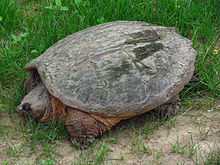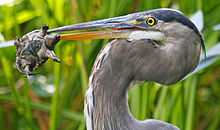Common snapping turtle
| Common snapping turtle | |
|---|---|
 | |
| Female searching for nest site | |
| Conservation status | |
| Scientific classification | |
| Kingdom: | Animalia |
| Phylum: | Chordata |
| Subphylum: | Vertebrata |
| Class: | Reptilia |
| Order: | Testudines |
| Family: | Chelydridae |
| Genus: | Chelydra |
| Species: | C. serpentina |
| Binomial name | |
| Chelydra serpentina (Linnaeus, 1758) | |
 | |
| Range map of C. serpentina | |
| Synonyms | |
| |
The common snapping turtle (Chelydra serpentina) is a large freshwater turtle of the family Chelydridae. Its natural range extends from southeastern Canada, southwest to the edge of the Rocky Mountains, as far east as Nova Scotia and Florida. This species and the larger alligator snapping turtle are the only two species in this family found in North America (though the common snapping turtle, as its name implies, is much more widespread).[2]
The common snapping turtle is noted for its belligerent disposition when out of the water, its powerful beak-like jaws, and highly mobile head and neck (hence the specific name serpentina, meaning "snake-like"). In some areas, they are hunted very heavily for their meat, a popular ingredient in turtle soup. Snapping turtles have a life-history strategy characterized by high and variable mortality of embryos and hatchlings, delayed sexual maturity, extended adult longevity, and iteroparity (repeated reproductive events) with low reproductive success per reproductive event. Females, and presumably also males, in more northern populations mature later (at 15-20 years) and at a larger size than in more southern populations (about 12 years). Lifespan in the wild is poorly known, but long-term mark-recapture data from Algonquin Park in Ontario, Canada suggest a maximum age over 100 years.[3]
Anatomy and morphology


C. serpentina has a rugged, muscular build with ridged carapaces (though ridges tend to be more pronounced in younger individuals). The carapace (upper shell) length in adulthood may be nearly 50 cm (20 in), though 25–47 cm (9.8–18.5 in), is more common.[4] C. serpentina usually weighs 4.5–16 kg (9.9–35.3 lb). Any specimen above the aforementioned weights are exceptional, but the heaviest wild specimen caught reportedly weighed 34 kg (75 lb). Snapping turtles kept in captivity can be quite overweight due to overfeeding and have weighed as much as 39 kg (86 lb). In the northern part of its range, the common snapping turtle is often the heaviest native freshwater turtle.[5]
Ecology and life history
Common habitats are shallow ponds or streams. Some may inhabit brackish environments, such as estuaries. Common snapping turtles sometimes bask—though rarely observed—by floating on the surface with only their carapaces exposed, though in the northern parts of their range, they also readily bask on fallen logs in early spring. In shallow waters, common snapping turtles may lie beneath a muddy bottom with only their heads exposed, stretching their long necks to the surface for an occasional breath (their nostrils are positioned on the very tip of the snout, effectively functioning as snorkels). Snapping turtles consume both plant and animal matter, and are important aquatic scavengers, but they are also active hunters that prey on anything they can swallow, including many invertebrates, fish, frogs, reptiles (including snakes and smaller turtles), unwary birds, and small mammals.

Common snapping turtles have few predators when older, but eggs are subject to predation by crows, mink, skunks, foxes, and raccoons. As hatchlings and juveniles predators include herons, bitterns, crows, hawks, bullfrogs, large fish, and snakes.[5]
These turtles travel extensively over land to reach new habitats or to lay eggs. Pollution, habitat destruction, food scarcity, overcrowding, and other factors drive snappers to move; it is quite common to find them traveling far from the nearest water source. This species mates from April through November, with their peak laying season in June and July. The female can hold sperm for several seasons, using it as necessary. Females travel over land to find sandy soil in which to lay their eggs, often some distance from the water. After digging a hole, the female typically deposits 25 to 80 eggs each year, guiding them into the nest with her hind feet and covering them with sand for incubation and protection. Incubation time is temperature-dependent, ranging from 9 to 18 weeks. In cooler climates, hatchlings overwinter in the nest. The common snapping turtle is remarkably cold-tolerant; radiotelemetry studies have shown some individuals do not hibernate, but remain active under the ice during the winter.[6] Although designated as "least concern" on the IUCN redlist, the species has been designated in the Canadian part of its range as "Special Concern" due to its life history being sensitive to disruption by anthropogenic activity.[7]
Systematics and taxonomy
Currently, no subspecies of the common snapping turtle are recognized.[8] The former subspecies osceola is now considered a synonym of serpentina, while the other former subspecies Chelydra rossignonii[9] and Chelydra acutirostris are both recognized as full species.[8][10]
Behavior
Snapping turtles have fierce dispositions;[11] but when encountered in the water, they usually slip quietly away from any disturbance.[12] Snapping turtles have evolved the ability to snap because, unlike other turtles, they are too large to hide in their shells when confronted. Snapping is their defense mechanism. Snapping turtles will bite humans if threatened, but as a last resort. The turtle will try to scare off threats by hissing before it bites.
The common snapping turtle is an aquatic ambush hunter, capturing its prey with its beak-like jaws.[12]
Captivity
The common snapping turtle is not an ideal pet. Its neck is very flexible, and a wild turtle can bite its handler even if picked up by the sides of its shell. A wild common snapping turtle will make a hissing sound when it is threatened or encountered; however, when in the water and unprovoked, they are fairly docile toward humans.
It is a common misconception that common snapping turtles may be safely picked up by the tail with no harm to the animal; in fact, this has a high chance of injuring the turtle, especially the tail itself and the vertebral column.[13] Lifting the turtle with the hands is difficult and dangerous. Snappers can stretch their necks back across their own carapace and to their hind feet on either side to bite. Also, their claws are sharp and capable of inflicting significant lacerations. When they feel stressed, they release a musky odor from behind their legs.
It may be tempting to rescue a snapping turtle found in a road by getting it to bite a stick and then dragging it out of immediate danger. This action can, however, severely scrape the legs and underside of the turtle and allow for deadly infections in the wounds. The safest way to pick up a common snapping turtle is by grasping the carapace above the back legs. There is a large gap above the back legs that allows for easy grasping of the carapace and keeps hands safe from both the beak and claws of the turtle.
Snapping turtles are raised on some turtle farms in China.[14]
Invasive species
In Italy in recent years, large mature adult C. serpentina turtles have been taken from bodies of water throughout the country. They were most probably introduced by the unwise release of pets. In March 2011, an individual weighing 20 kg (44 lb) was captured in a canal near Rome;[15] another individual was captured near Rome in September 2012.[16]
In politics

The common snapping turtle was the central feature of a famous American political cartoon. Published in 1808 in protest at the Jeffersonian Embargo Act of 1807, the cartoon depicted a snapping turtle, jaws locked fiercely to an American trader who was attempting to carry a barrel of goods onto a British ship. The trader was seen whimsically uttering the words "Oh! this cursed Ograbme" ("embargo" spelled backwards). This piece is widely considered a pioneering work within the genre of the modern political cartoon.
In 2006, the snapping turtle was declared the state reptile of New York by a sweeping vote of the New York Legislature after being popularly chosen by the state's public elementary school children.[17]
References
- ↑ Chelydra serpentina, IUCN
- ↑ C.H. Ernst (2008). "Systematics, Taxonomy, and Geographic Distribution of the Snapping Turtles, Family Chelydridae". In A.C. Styermark, M.S. Finkler, R.J. Brooks. Biology of the Snapping Turtle (Chelydra serpentina). Johns Hopkins University Press. pp. 5–13.
- ↑ "COSEWIC Assessment and Status Report on the Snapping Turtle Chelydra serpentina".
- ↑ Kindersley, Dorling (2001,2005). Animal. New York City: DK Publishing. ISBN 0-7894-7764-5. Check date values in:
|date=(help) - ↑ 5.0 5.1 Virginia Herpetological Society: Eastern Snapping Turtle Chelydra serpentina serpentina
- ↑ US Army Corps of Engineers, Engineer Research and Development Center, Environmental Laboratory: Common Snapping Turtle (Chelydra serpentina)
- ↑ COSEWIC. "Species Profile - Snapping Turtle". Species At Risk Public Registry. Government of Canada. Retrieved 24 February 2012.
- ↑ 8.0 8.1 Rhodin, Anders G.J.; van Dijk, Peter Paul; Inverson, John B.; Shaffer, H. Bradley (2010-12-14). "Turtles of the world, 2010 update: Annotated checklist of taxonomy, synonymy, distribution and conservation status". Chelonian Research Monographs 5: 000.xx. doi:10.3854/crm.5.000.checklist.v3.2010. ISBN 0965354091. Archived from the original on 2010-12-15.
- ↑ van Dijk, P.P., J Lee, J., Calderón Mandujano, R., Flores-Villela, O., Lopez-Luna, M.A. & Vogt, R.C. (2007). Chelydra rossignoni. In: IUCN 2008. IUCN Red List of Threatened Species. Retrieved 2009-05-04.
- ↑ Chelydra, Reptile Database
- ↑ Snapping Turtle, Encyclopedia.com
- ↑ 12.0 12.1 Common Snapping Turtle, Nature.ca
- ↑ Indiviglio, Frank (2008-06-24). "Handling Snapping Turtles, Chelydra serpentina, and Other Large Turtles". That Reptile Blog. That Pet Place. Retrieved 2008-07-20.
- ↑ Fang Anning (方安宁), "“小庭院”养殖龟鳖大有赚头" (Small-scale turtle farming may be very profitable). Zuojiang Daily (左江日报) (with photo)
- ↑ Una "azzanatrice" catturata fuori Roma. March 17, 2011. Corriere della Sera. Milan.
- ↑ http://www.ansa.it/web/notizie/photostory/curiosita/2012/09/17/Tartaruga-azzannatrice-presa-Tevere_7489581.html
- ↑ Medina, Jennifer (2006-06-23). "A Few Things Lawmakers Can Agree On". N.Y./Region (New York Times). Retrieved 2008-07-20.
External links
| Wikispecies has information related to: Chelydra serpentina |
| Wikimedia Commons has media related to Chelydra serpentina. |
- The Snapping Turtle Page - www.chelydra.org
- Snapping Turtle - Chelydra serpentina Species account from the Iowa Reptile and Amphibian Field Guide
- Common Snapping Turtle, Natural Resources Canada
- Video: How to Help a Snapping Turtle Cross A Road from the Toronto Zoo
| ||||||||||||||||||
| ||||||||||||||||||||||||||||||||||||||||||||||||||||||||||||||||||||||||||||||||||||||||||||||||||||||||||||||||||||||||||||||||||||||||||||||||||||
